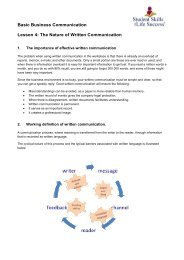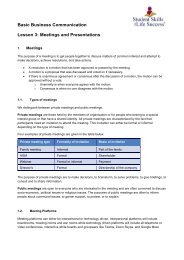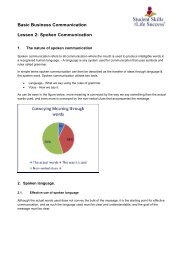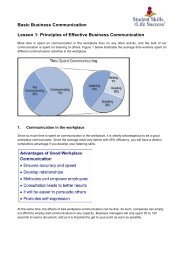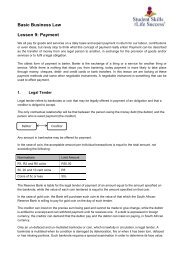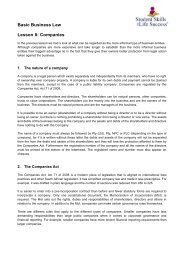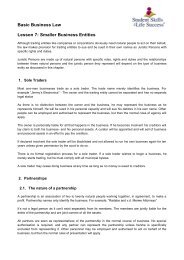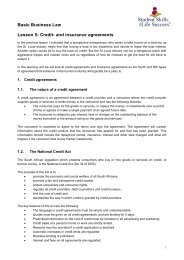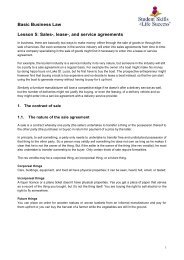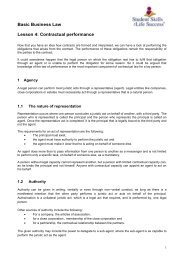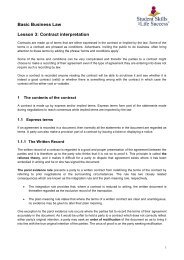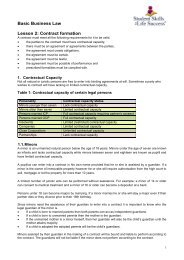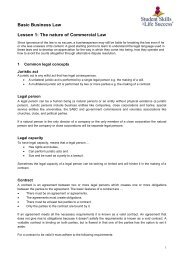Purchasing and Financing 2024
Purchasing- and Financial Management For 2nd year CATS learners. Aligned to the outcomes of the German accredited certification: “Industrie Kaufmann/frau”.
Purchasing- and Financial Management
For 2nd year CATS learners.
Aligned to the outcomes of the German accredited certification: “Industrie Kaufmann/frau”.
Create successful ePaper yourself
Turn your PDF publications into a flip-book with our unique Google optimized e-Paper software.
When evaluating the Growth of a Business the Net Profit Margin must be calculated <strong>and</strong><br />
when evaluating the Returns on Investment in a Company, both the Return on Equity <strong>and</strong><br />
the Return on Assets must be calculated.<br />
Evaluating the Financial Condition <strong>and</strong> Liquidity of a company<br />
a. Short Term Financial Condition <strong>and</strong> Liquidity<br />
Firstly, we must consider whether a business can pay its debts to remain in operation.<br />
Under the Accrual Accounting Method, the revenue is recognized when earned, whether<br />
cash is received as payment. Since sales may be on credit, even profitable companies may<br />
be at risk due to too much debt or a shortage of liquid assets.<br />
To evaluate the short-term financial condition <strong>and</strong> liquidity of a company we must analyse<br />
the Balance Sheet <strong>and</strong> calculate the Current Ratio, the Quick Ratio, <strong>and</strong> Working Capital.<br />
1. Current Ratio = Current Assets/Current Liabilities<br />
This accounting ratio measures the ability of a company to pay its debts over the next 12<br />
months. As a rule, a company should have more than twice the assets to pay debt<br />
obligations, or a ratio equal or greater than two. Anything below one is an indication that<br />
the company may not be able to meet its short-term financial obligations.<br />
Because short-term assets can be quickly turned into cash quickly, it is also a measure of<br />
market liquidity. Ratios that are too high may indicate that assets are not being utilized<br />
efficiently. This is not as concerning as a low ratio but may affect long-term growth.<br />
As with all Accounting Formulas <strong>and</strong> ratios, each should be compared to the relative<br />
industry <strong>and</strong> competition. Often each industry has its own st<strong>and</strong>ard for acceptable<br />
amounts. For example, luxury items may need a higher ratio during economic downturns<br />
since consumers are less likely to purchase luxury items when budgets are tight.<br />
2. Quick Ratio (Acid Test) = (Current Assets - Inventory)/Current Liabilities<br />
Though inventory is a current asset, it is more difficult to liquidate, <strong>and</strong> values more<br />
difficult to determine. Products no longer in dem<strong>and</strong> are often liquidated at steep<br />
discounts, which often occur in the retail industry during seasonal changes.<br />
The Quick Ratio, or acid test, is therefore a better measure of liquidity as it only includes<br />
those assets that are more easily convertible to cash (Quick Assets), such as cash<br />
equivalents, receivables, <strong>and</strong> marketable securities.<br />
A ratio of 1.5 or more is considered adequate to cover short term debts, <strong>and</strong> a ratio of less<br />
than one is a clear warning signal that a company may not be able to pay its short-term<br />
debts. Industry st<strong>and</strong>ards should always be considered when comparing the ratios.<br />
43




